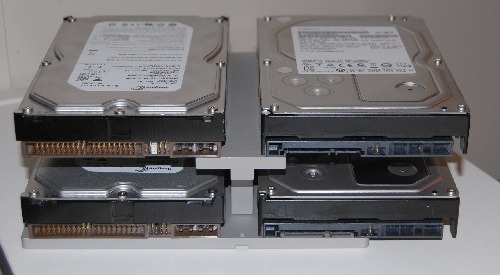I've been working with Mac hosting for about thirteen years. I tell people about using a Mac mini as a server and they just love the idea of it. There are a lot of great hosting options out there these days, but it's nice to work with a server where the OS is familiar and you know you control the whole stack of hardware and software. Our base Mac mini subscription starts at just $79/mo (that includes the server) so it's much easier to get started.
To get your file server up and running, you only need two things: a Mac running OS X. Setting Up Windows Home Server Once you've build your server, it's time to get Windows Home Server installed. Without this OS, there's really nothing different between the server and any desktop PC. In fact, that's why you can easily repurpose an old desktop as a home server just by installing WHS.
Five years ago today, I wrote a post about ways you might use a Mac server. I’ve decided to update that list and add some new ones that have come along in the last little while. It’s a mix of Mac apps, open source projects, and iOS tools. Now when you say to yourself “I’d love to try a Mac server but I just don’t know what I’d do with it” then you can take a look at this list. (Have more suggestions? Add them here.)
Use Mac mini as a server The most popular server features—File Server, Time Machine Server, and Caching Server—are a part of macOS, so it’s easy to use your Mac mini as a server. Click the System Preferences icon in the Dock, then click Sharing to access one or more of the options below. Windows Home Server makes light work of sharing files, streaming media and performing automatic backups from multiple PCs. We'll show you how to build your own home server by recycling an old PC.
Ways to use your Mac Server
macOS server is in the middle of a big transition, but I'm still including it here. You'll want to be sure to read up on the future roadmap. It's a first party way to run a Profile Manager and Open Directory.
There are a number of ways to use your Mac as a build server. It’s easily the most popular use here at MacStadium. You might look at Jenkins, Buildkite, Teamcity, Veertu, or Gitlab.
Xcode now includes Xcode Server. We have a guide for setting up Xcode 9 Server that may be helpful.
Resilio is a file sync server built on bit torrent technology. It's very good for large files. Here is a tutorial to setup a file server with Resilio on a Mac mini.

Selfoss is a web based RSS reader that is open source and free.

Screens will let you use a Mac from your iPad or iPhone.
NuoRDS is a scalable terminal server for Mac. Here are some setup instructions.
Hazel is an automation tool that can keep your Mac server clean. (I use it to offload things from Dropbox, make a copy of full resolution images, etc. Just set it up and let it run. It's especially useful for people who use an iOS device full time but want a Mac to do some heavy lifting in the background without much interaction.)
Sendy is a self hosted service to email your newsletters at a significant discount. Similar to MailChimp.
Guacamole is a client-less remote desktop gateway. You can control your machine without needing a client (and just a browser using HTML5.)
Yourls is a self-hosted URL shortener. It provides stats as well.
Pow lets you create a quick environment to build and test Rails apps.
Use Transmit to access your Mac as a file server. Here’s a short tutorial.
Moodle is a CMS for education.
VirtualHostX lets you setup multiple websites quickly on a Mac. It comes with it's own self-contained Apache web server as well.
Owncloud is a replacement for Dropbox, but also provides calendar, contacts and so much more.
Plex lets you stream all your media to your phone/tablet/Macs/etc.
FileMaker is a powerful database server. Very Powerful. Run it for yourself or as a paid service for others.
Kerio is a powerful Mail server. A very good alternative to Exchange.
Run a Minecraft Server of your own.
uTorrent is a simple torrent client.
ServerPilot makes it simple and fast to create and maintain Wordpress installs. Built for DigitalOcean, but works great on a Mac mini with Ubuntu.
MAMP will help you setup a WordPress blog quickly with PHP and mySQL.
DNS Enabler lets you run your own DNS server.
BBpress is clean forum software from the makers of WordPress.
Discourse is a platform to build a community. It's modern and free for self hosted. We use Discourse for our own community site.
Simon is an application that will monitor all sorts of servers and services and notify you if they're down.
iStat Server will let you keep an eye on your Mac server.
Asterisk is an open source VOIP server.
Deep Freeze will let you really hack on your machine, and bring it back clean with a restart.
Nagios will keep an eye on your infastructure.
VMware ESXi will let you install and run multiple instances of OS X on the same server (and we'll install it for you when you start a Mac mini subscription.)

Pancake is a seller self hosted app for invoicing and billing clients.
GridRepublic or Warrior will let you put your extra server power to good use.

Tell us how you use your Mac server
Do you have more software suggestions? Feel free to add them as a comment on our community forum. (And don’t be shy about sending your own software. We’re always happy to work with developers.)
Note:
This material is open source and free to copy, teach and/or modify according to your needs. It follows the main principals of OER, Open Educational Resources philosophy and it’s policies.
Hello and Welcome to our online course!
This course is for anyone that wants to learn the fundamentals of having a home server. The course is geared for the Mac OS X Client computer (…and, client means any computer running the Mac OS X operating system) but you probably can use many sections of this course for Windows and Linux. All software mentioned on this course is open source and available both for Windows and Linux.
The complete list of open-source software can be accessed at Internet Society. Please, become a member, connect with me, and access the entire list.

Internet Society | Course Software List
https://bit.ly/2kN44bm
* For those that are interested in this course, if you continue reading the material, you will find out how to access this open-source material without having to join the Internet Society.
I will try my best to not overwhelming you initially with tons of information. At the course ends, we will advance towards extra technical topics.
Some of you might ask the question?
Why should I have my server and hold the responsibility of maintaining if I can have a Cloud Server and just run my enterprise from there?
Yes, many of you will probably choose to run a cloud server where someone else will be holding your data. However, learning how to have your server it is fun and it could be cheaper in the long run.
First, You do not need to pay for space, you can use your own space. In a cloud server, you will be going to have to trust the platform of this cloud server and you are going to have to learn sharing permissions and file encryption. If you make a mistake uploading a sensitive document with the wrong permissions, you are screwed.
Build A Home Server For Macbook Pro
The other main advantage of running your server is that you will learn a lot, especially in the area of cybersecurity. What other people teach on the theory you will experience in practical, empirical ways through administrating your server every day.
Besides, I do not have a problem if you decide to run your server in the cloud. There is some open-source software you can access to achieve your goals. I do not advise to get any proprietary software unless you have a basic business income and a budget to invest.
For single individuals, I like very much NextCloud. They are open source and give you some space for free to start. NextCloud gives you 5 GB of free space (with a server indication) and I think that is enough for a single person to start to play with it. If you start to grow beyond that cap, you will need to pay for more space.
This class is about learning how to build your server at home!
The cheapest way to run a server and serve some domains plus websites. You will learn how to serve 3 or more different domains with one single ip address. For that, you should learn your limitations and your software configuration. This class will greatly speed up your knowledge on the subject.
Ready! Ok, let’s go!;
Building A Home Server For Backups
Click on this link or on the Tutorial top menu.
